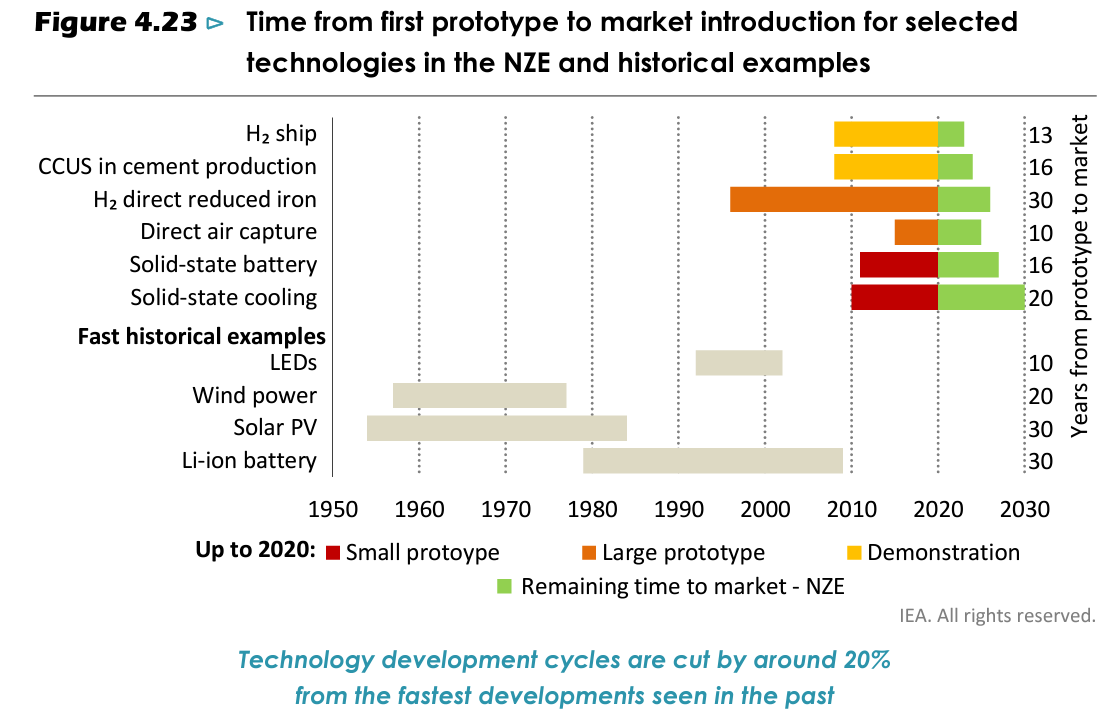
Smart Grids, Electrification and Emerging Technologies – Optimistic Predictions for the Upcoming Decades
As we accelerate into a future charged by innovation, the quest for sustainable energy takes us beyond mere renewables. In this crucial junction, the International Energy Agency (IEA) illuminates the path forward, offering insights that are not only essential but revolutionary. This is more than just a sequel to a plan; it's a guide to action that explores the burgeoning realm of electrification, smart grid technologies, and groundbreaking advancements yet to reach their prime. Welcome to part two of our series, where electric vehicles move beyond novelty, smart grids evolve into intelligent networks, and emerging technologies promise to redefine our relationship with energy itself.
8 min read
In this Article:
- How EVs are set to dominate the global car market.
- Why quadrupling grid flexibility by 2050 is crucial.
- The billions needed in transmission, distribution grids, and EV charging points.
- The future impact of hydrogen, advanced batteries, and direct air capture.
Introduction
Continuing from our previous article, where we delved into the rise of renewable energy and the significant role of advanced energy storage solutions, this installment will focus on the equally transformative arenas of electrification, smart grid advancements, and emerging technologies. Leveraging insights from the IEA’s landmark “Net Zero by 2050: A Roadmap for the Global Energy System,” we will explore the surge in electric vehicle sales, the necessity for more flexible and intelligent electricity grids, and the cutting-edge technologies that are still in their infancy but are expected to contribute significantly to emissions reductions. So, let’s journey further into the intricacies of the global shift towards a clean and sustainable energy future.
The Global Shift Towards Electrification
As we transition into an age defined by sustainability and cleaner energy, electrification has emerged as a focal point of global innovation and policy directives. At the heart of this movement lies the automotive sector, with electric vehicles (EVs) revolutionizing transportation. The ambitious projection, with EVs anticipated to account for over 60% of global car sales by 2030, heralds a profound transformation of our global energy landscape.
Surge in Electric Vehicle (EV) Sales
Growing Consumer Demand: Driven by increasing awareness about environmental sustainability, consumers globally are leaning more towards EVs. Government incentives, falling battery costs, and a broader range of vehicle options are further fuelling this demand.
Policy Push: Governments worldwide are setting ambitious targets to phase out gasoline and diesel-powered vehicles. Tightening emission norms, tax incentives for EV buyers, and stricter fuel efficiency standards are ushering in an era dominated by electric vehicles.
Innovative Technological Advancements: Battery technology, a major determinant of an EV’s appeal, has seen significant advancements in terms of energy density, charge cycles, and cost. This is supplemented by enhancements in motor efficiency, power electronics, and lightweight vehicle design.
Broader Impacts of Electrification Trend
Energy Demand & Supply Dynamics: The swift adoption of EVs presents a unique challenge for energy providers. While oil demand is expected to plummet, there will be a significant surge in electricity demand. This transition mandates massive investments in renewable energy sources and grid infrastructure to cater to this evolving demand without compromising on the environment.
Infrastructure Overhaul: The rise of EVs necessitates an extensive EV charging infrastructure. The report points towards a staggering rise from around 1 million public charging points today to 40 million by 2030. This means a robust, widespread, and efficient charging network, requiring significant capital inflow, technology adoption, and policy support.
Economic Repercussions: Traditional automobile industries, especially those rooted in internal combustion engine (ICE) technology, face potential downturns. In contrast, industries aligned with EV production, including battery manufacturing, electric motor production, and power electronics, are poised for unprecedented growth.
Environmental Benefits: A shift to EVs results in decreased greenhouse gas emissions and reduced air pollutants. This will play a crucial role in cities grappling with air quality issues and contribute significantly to global carbon mitigation efforts.
Geopolitical Ramifications: The decreased reliance on oil alters global geopolitical dynamics, potentially reducing conflicts centered on oil resources. On the flip side, nations with vast reserves of minerals required for battery production, like lithium, cobalt, and nickel, may find themselves at the strategic epicenter of the new energy economy.
In sum, the electrification of the transportation sector, symbolized by the meteoric rise of EVs, is not just a technological evolution—it’s a socio-economic and environmental revolution. The broader ramifications span energy grids, global markets, environmental policies, and societal norms, redefining the way we perceive transportation and energy. As the world strives for a sustainable future, the electrification trend, underscored by the surge in EVs, emerges as a cornerstone of this global endeavor.
Infrastructure & Smart Grid Advancements
In the age of burgeoning renewable energy sources and electrification, the quintessential power grid is undergoing a transformative overhaul. This transformation isn’t just about adding capacity; it’s about reimagining and reinventing the entire energy infrastructure to be more adaptive, responsive, and capable of handling the fluctuating dynamics of renewable energy and surging demand from sectors like electric transportation. The nexus of this transformation is the development of ‘smart grids’ and substantial enhancements in infrastructure flexibility.
The Imperative for a Flexible Electricity Grid
Evolving Energy Landscape: The increasing share of renewable energy, especially from intermittent sources like solar and wind, presents a fluctuating supply pattern. This mandates a grid that can dynamically respond to the variations in energy generation and demand.
Rising Demands from Electrification: As the world leans heavily into electrification, particularly with the EV surge, there will be new patterns of demand—both in volume and in timing—that grids will need to accommodate.
Quadrupling Flexibility by 2050: The report underscores the urgency, emphasizing the need to increase electricity system flexibility fourfold by 2050. This entails a mix of technological, policy, and infrastructural shifts.
Spearheading Investments in Grid Infrastructure
Transmission and Distribution Grids: These are the backbone of any electricity system. The projected expansion is colossal—annual investment needs to catapult from USD 260 billion today to USD 820 billion by 2030. The focus will be on enhancing capacity, reducing transmission losses, and incorporating advanced technologies to manage and direct flow efficiently.
EV Charging Infrastructure: The electrification of transportation places a renewed emphasis on accessible and efficient charging solutions. From a modest 1 million public charging points today, a massive expansion to 40 million is anticipated by 2030. This requires not only capital but also innovation in fast-charging technologies, grid integration, and user interface solutions.
Integrating Energy Storage: Alongside generation and transmission, energy storage solutions, especially batteries, play a crucial role in providing grid flexibility. They allow for the storage of excess energy during periods of low demand or high generation and its release during peak demand, effectively acting as buffers and stabilizers.
Towards Smart Grids
Digital Transformation: Modern grids will leverage digital technologies, from advanced sensors and Internet of Things (IoT) devices to artificial intelligence, to monitor, predict, and manage energy flows efficiently.
Decentralization & Microgrids: A move towards decentralized energy systems, including microgrids, allows for better local energy management, resilience against disruptions, and efficient integration of renewable sources.
Consumer Engagement: Smart grids offer consumers the tools to be active participants, from real-time energy usage data to demand-side management options, fostering energy-saving behaviors and decentralized energy production (like rooftop solar panels).
In conclusion, as the global energy landscape pivots towards sustainability and innovation, the infrastructure underpinning it all—the grids—must advance in tandem. This means unprecedented investments, cutting-edge technology integrations, and a renewed vision of what a 21st-century energy infrastructure should look like. The goal is clear: a responsive, resilient, and smart grid system that stands at the heart of our sustainable future.
The Role of Emerging Technologies
As the world relentlessly pursues the monumental goal of net-zero emissions by 2050, the integration of mature renewable technologies alone may not suffice. In this intricate dance to decarbonize our energy landscape, emerging technologies—many of which are still in nascent stages of development—will play a starring role. The roadmap sketched out by the IEA’s report emphasizes that nearly half of the required emissions reductions by 2050 are projected to emerge from technologies that, as of now, exist predominantly in the realms of demonstration projects or are at the prototype phase.
The Important Technological Breakthroughs
Hydrogen: This simple molecule holds transformative potential. As a clean, versatile, and energy-dense medium, hydrogen could revolutionize sectors hard to electrify, like heavy industry and long-haul transportation. The push is for green hydrogen—produced using renewable energy—which, when scaled, could provide vast quantities of carbon-free energy. Beyond energy, hydrogen can act as a storage solution, balancing intermittent renewable sources.
Advanced Batteries: While lithium-ion batteries have paved the way for current electric vehicles and energy storage solutions, the next generation of battery technologies—be it solid-state, flow batteries, or other novel chemistries—promises higher energy densities, faster charging, longer lifespans, and potentially lower costs. Their evolution will be pivotal in enhancing the storage capabilities essential for a renewable-dominated grid.
Direct Air Capture (DAC): A futuristic solution that’s gaining traction, DAC involves machines that function almost like synthetic trees, ‘inhaling’ CO2 directly from the atmosphere and either storing it or converting it into useful products. As the world grapples with the dual challenge of reducing current emissions and addressing the historical carbon overhang, DAC offers a promise of not just slowing the carbon clock but potentially turning it back.
Carbon Capture, Utilization, and Storage (CCUS): While DAC focuses on ambient air, CCUS targets high-emission sources like power plants and factories, capturing carbon before it enters the atmosphere. The captured carbon can either be stored safely underground or utilized in industries, from creating synthetic fuels to enhancing building materials.

Challenges and Path Forward
While the potential of these emerging technologies is vast, they come with their own set of challenges:
Scaling and Commercialization: Moving from prototypes and demonstration projects to large-scale, commercially viable operations is a significant leap. It requires substantial R&D investments, supportive policies, and industry collaboration.
Infrastructure Needs: Technologies like hydrogen and CCUS demand new infrastructural ecosystems, from pipelines to storage facilities.
Cost Parity: Many of these solutions currently come with high price tags. Achieving cost parity with existing technologies, through innovation and economies of scale, will be crucial for their widespread adoption.
In essence, while the renewable revolution will be underpinned by technologies we’re familiar with today, achieving the 2050 vision demands that we also place our bets on the technological frontiers of tomorrow. The blend of mature and emerging solutions is what will steer our planet towards a sustainable and carbon-neutral future.




